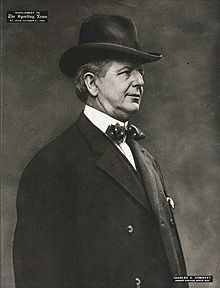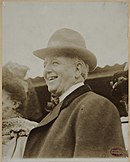Charles Comiskey
| Charles Comiskey | |
|---|---|
 Comiskey c. 1909 | |
| First baseman/Manager/Owner | |
| Born:August 15, 1859 Chicago, Illinois,U.S. | |
| Died:October 26, 1931(aged 72) Eagle River, Wisconsin,U.S. | |
Batted:Right Threw:Right | |
| MLB debut | |
| May 2, 1882, for the St. Louis Brown Stockings | |
| Last MLB appearance | |
| September 12, 1894, for the Cincinnati Reds | |
| MLB statistics | |
| Batting average | .264 |
| Home runs | 28 |
| Runs batted in | 883 |
| Stolen bases | 416 |
| Managerial record | 840–541 |
| Teams | |
As player
As manager As Owner | |
| Career highlights and awards | |
| |
| Member of the National | |
| Induction | 1939 |
| Election method | Old-Timers Committee |
Charles Albert Comiskey(August 15, 1859 – October 26, 1931),nicknamed"Commy"or"the Old Roman",was an AmericanMajor League Baseballplayer,managerand team owner. He was a key person in the formation of theAmerican League,and was also founding owner of theChicago White Sox.[1]Comiskey Park,the White Sox's storied baseball stadium, was built under his guidance and named for him.[1]
Comiskey's reputation was permanently tarnished by his team's involvement in theBlack Sox Scandal,although he was inducted as an executive into theBaseball Hall of Famein1939.[1]
Early life
[edit]Comiskey was born on August 15, 1859, inChicago,the son of Illinois politicianJohn Comiskey.He attended public and parochial schools in Chicago, includingSt. Ignatius Preparatory School,and, later,St. Mary's College(inSt. Mary's, Kansas). He played baseball at St. Mary's, and played for several professional teams in Chicago while apprenticed to a plumber and working at construction jobs including driving a brick delivery wagon for the construction crews building the fifth Chicago City Hall, which stood from 1873 to 1885.[2]
Baseball career
[edit]Playing and managing career
[edit]Comiskey started his playing career as apitcher,and moved tofirst baseafter developing arm trouble. He is credited with being the first to play hitters off of first base, allowing him to cover balls hit to more of the infield. He entered theAmerican Associationin 1882 with theSt. Louis Brown Stockings.[3]He managed the team during parts of its first seasons and took over full-time in 1885,[3]leading the Browns to four consecutiveAmerican Associationchampionships and a close second in 1889.[4]He also played and managed for theChicago Piratesin thePlayers' League(1890), theBrownsagain (1891), and theCincinnati Redsin theNational League(1892–1894).[5]
As an owner
[edit]
Comiskey left Cincinnati and the majors in fall 1894 to purchase theWestern LeagueSioux City Cornhuskers inSioux City, Iowaand move it toSaint Paul, Minnesota,renaming the team the St. Paul Saints.[3]He had compiled a.264batting averagewith 29home runs,883RBIand 419stolen bases.As a manager, he posted an 839-542 record. After five seasons of sharing the Twin Cities with another Western League club inMinneapolis,Comiskey and his colleagues arranged to share Chicago with theNational League,whose club (theChicago Cubstoday) played on the West Side. The St. Paul Saints moved to the South Side as the White Stockings of the renamedAmerican Leaguefor the 1900 season (which was also the original name of the Cubs; it was eventually shortened to White Sox). The American League then declared itself a major league starting in 1901.[3]

As owner of the White Sox from 1900 until his death in 1931, Comiskey oversaw buildingComiskey Parkin 1910 and winning five American League pennants (1900, 1901, 1906, 1917, 1919) and two World Series (1906, 1917).[3]He lost popularity with his players, who eventually came to despise him. The players' animosity toward Comiskey was seen as a factor in theBlack Sox scandal,when eight players on the AL champions conspired to "throw" the1919 World Seriesto the NL championCincinnati Reds.[3]Comiskey was notoriously stingy (his defenders called him "frugal" ), even forcing his players to pay to launder their own uniforms.[3]Traci Peterson notes that, in an era when professional athletes lacked free agency, the White Sox's formidable players had little choice but to accept Comiskey's substandard wages. She writes: "Swede RisbergandLefty Williamsmade less than $3,000 a year ($52,722 today).Joe JacksonandBuck Weavermade only $6,000 a year ($105,443 today).Eddie Cicottehad been promised a $10,000 ($175,739 today) bonus if he could win 30 games in a season. When Cicotte closed in on the 30-game goal, Comiskey had him benched to keep him from reaching the mark. "[3]Comiskey's stated reason for having managerKid Gleasonbench Cicotte was that with the Sox headed for the World Series he had to protect his star pitcher's arm (Cicotte ended up with a 29-7 record for the 1919 season). In one incident, he promised his players a bonus for winning the 1919 pennant — the "bonus" turned out to be a case of flat champagne.[6]
When the scandal broke late in the 1920 season, Comiskey suspended the suspected players, while admitting in the telegram he sent to them that he knew this action cost the White Sox a second straight pennant. However, he initially defended the accused players and, in an unusual display of largesse, provided them with expensive legal representation. He ultimately supported baseball commissionerKenesaw Mountain Landis' decision to ban the implicated White Sox players from further participation in professional baseball, knowing full well that Landis' action would permanently sideline the core of his team.[3]Indeed, the White Sox promptly tumbled into seventh place and would not be a factor in a pennant race again until1936,five years after Comiskey's death, and did not win another pennant until1959.
Legacy
[edit]
Comiskey is sometimes credited with the innovation of playing thefirst baseposition behind first base or inside the foul line, a practice which has since become common.[3]Later he had played a large role in the dissolution of theNational Commission,baseball's former body of authority, following a quarrel withBan Johnson.[7]He was inducted into theNational Baseball Hall of Famein 1939.[1]He was also named to theSt. Louis CardinalsHall of Fame in May 2022, as the selection of Cardinals managing partnerWilliam DeWitt Jr.for his accomplishments as manager of the St. Louis Browns.[8]
Comiskey died inEagle River, Wisconsinin 1931, and was buried atCalvary Cemeteryin Evanston. Comiskey's sonJ. Louisinherited the team but died a few years later. The trustees of his estate were going to sell the team, but J. Louis' widowGracewas able to gain control of the team and avoid a sale. Her two children,Dorothy Comiskey RigneyandCharles "Chuck" Albert Comiskey II(who served in the White Sox front office in the 1940s and 1950s before he became owner),[9]became co-owners of the team following Grace's death in the 1950s.[7]Dorothy sold controlling interest in the team toBill Veeckin 1958, but Chuck remained a minority owner until 1962.[10]
When the White Sox moved to a new ballpark in 1991, theComiskey Parkname was carried over from their previous home (since 1910); it is now known asGuaranteed Rate Field.A statue of Comiskey stands near center field in the new ballpark.
Career statistics
[edit]As a manager
[edit]| Team | From | To | Record | ||
|---|---|---|---|---|---|
| W | L | Win % | |||
| St. Louis Browns | 1883 | 1883 | 12 | 7 | .632 |
| St. Louis Browns | 1884 | 1889 | 465 | 214 | .685 |
| Chicago Pirates | 1890 | 1890 | 75 | 62 | .547 |
| St. Louis Browns | 1891 | 1891 | 86 | 52 | .623 |
| Cincinnati Reds | 1892 | 1894 | 202 | 206 | .495 |
| Total | 840 | 541 | .608 | ||
| Ref.:[5] | |||||
See also
[edit]- List of Major League Baseball career stolen bases leaders
- List of Major League Baseball player-managers
- List of St. Louis Cardinals team records
References
[edit]- ^abcd"Charlie Comiskey".Baseball Biography.RetrievedDecember 27,2007.
- ^Hornbaker, Tom (March 14, 2014).Turning the Black Sox White: The Misunderstood Legacy of Charles A. Comiskey.Sports Publishing. pp. 11–20.ISBN978-1613216385.
- ^abcdefghij"Charles" The Old Roman "Comiskey".University of Missouri-Kansas City School of Law. Archived fromthe originalon January 13, 2008.RetrievedDecember 27,2007.
- ^"1889 American Association Season Summary".
- ^ab"Charlie Comiskey".Baseball Reference.Sports Reference LLP.RetrievedAugust 2,2016.
- ^Chicagoan, Anonymous."Chicago White Sox: Shoeless Joe Jackson Awaits Justice 50 Years After His Death".bleacherreport.com.Bleacher Report, Inc. Turner Broadcasting System, Inc.RetrievedDecember 15,2022.
- ^abCreamer, Robert (February 24, 1958)."The Comiskey Affair".Sports Illustrated.RetrievedFebruary 22,2014.
- ^"Holliday, Javier, Comiskey named to Cardinals' Hall of Fame".St. Louis Post Dispatch.May 27, 2022.RetrievedMay 27,2022.
- ^"Charles Albert Comiskey II, 81, a White Sox boss, is dead".The New York Times.August 28, 2007.RetrievedFebruary 22,2014.
- ^Purdy, Dennis (2006).The Team-by-Team Encyclopedia of Major League Baseball.New York City: Workman Publishing Company.ISBN0-7611-3943-5.
Further reading
[edit]- Riehle, Dave, "Say it Ain't So, Charlie:The 1897 Dispute Between Charles Comiskey and the St. Paul Labor Trades",Ramsey County History QuarterlyV39 #2,Ramsey County Historical Society,St Paul, Minnesota, 2004.
- Axelson, Gustaf W. (1919).""Commy": the life story of Charles A. Comiskey, the "Grand old Roman" of baseball and for nineteen years president and owner of the American league baseball team "The White Sox,"".Chicago: Reilly & Lee Co.
{{cite journal}}:Cite journal requires|journal=(help).
External links
[edit]- Career statistics and player information fromBaseball Reference,orBaseball Reference (Minors)
- Charles Comiskey managerial career statisticsatBaseball-Reference.com
- Charles Comiskeyat theBaseball Hall of Fame
- 1859 births
- 1931 deaths
- 19th-century baseball players
- Major League Baseball player-managers
- Chicago Pirates players
- Chicago White Sox executives
- Chicago White Sox owners
- Cincinnati Reds managers
- Cincinnati Reds players
- Major League Baseball first basemen
- Major League Baseball owners
- Minor league baseball managers
- National Baseball Hall of Fame inductees
- St. Louis Browns (AA) managers
- St. Louis Browns (AA) players
- St. Louis Brown Stockings (AA) players
- Troy Haymakers players
- Dubuque Red Stockings players
- St. Paul Apostles players
- St. Paul Saints (Western League) players
- Baseball players from Chicago
- Comiskey family
- People from Eagle River, Wisconsin
- St. Ignatius College Prep alumni
- Burials at Calvary Cemetery (Evanston, Illinois)


